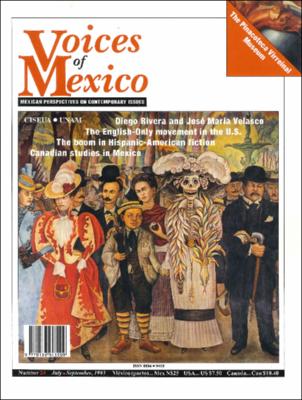Mostrar el registro sencillo del ítem
Voices of Mexico: Mexican Perspectives on Contemporary Issues
| dc.rights.license | http://ru.micisan.unam.mx/page/terminos | |
| dc.contributor.editor | Toro Gayol, Marybel | |
| dc.contributor.other | Velasco Montante, Astrid | |
| dc.date.accessioned | 2018-12-04T00:35:40Z | |
| dc.date.accessioned | 2022-02-17T00:15:41Z | |
| dc.date.available | 2018-12-04T00:35:40Z | |
| dc.date.available | 2022-02-17T00:15:41Z | |
| dc.date.issued | 1993 | |
| dc.identifier.issn | 0186-9418 | |
| dc.identifier.uri | https://ru.micisan.unam.mx/handle/123456789/16731 | |
| dc.format | application/pdf | |
| dc.format.extent | 104 pp. | |
| dc.language.iso | eng | |
| dc.publisher | Universidad Nacional Autónoma de México, Coordinación de Humanidades, Centro de Investigaciones sobre Estados Unidos de América | |
| dc.relation.isformatof | ||
| dc.relation.haspart | Our Voice / Margáin, Hugo B.; Canadian Studies in Mexico: A New Challenge / Verea Campos, Mónica; Colonial Mexican Painting and the Pinacoteca Virreinal Museum / Armella de Aspe, Virginia; The English-Only Movement in the U.S. / Toro Gayol, Marybel; Lust in Translation:The Boom in Hispanic-American Fiction / Stavans, Ilán; Topolobampo: A New Port On the Pacific / Mercado Celis, Alejandro; The Political Economy of Drugs: Conceptual Issues and Policy Options (Part 1) / Smith, Peter H. The Roots of Thought / Barjau, Luis; The Pre-Hispanic Writers / Henestrosa, Andrés; José María Velasco and the Chicago International Exhibition / Altamirano Piolle, María Elena; Diego María Rivera: From Cubism To The Revolutionary Mural/ Rivera Marín, Guadalupe; On National Identity and Postmodernism / González M., José Luis; Philantropy as a New Global Ethic / Arango, Manuel; Awards / Villanueva, Raquel; Perceptions on Mexican art & Culture in the 1990s / Álvarez Padilla, Alfredo; Mario Pani, Cantinflas and Cesar Chavez / Montiel Ziegler, Elsie; Blas Galindo, Prolyfic Composer / Toro Gayol, Marybel; The 21st Century National Medical Center / Isaak, Dinorah; The Sculptures of University City / Cruz González Franco, Lourdes; The Last Pleasure / Casas, Rosamaría; The Sonora Yaquis / Luna Parra, Georgina; The Fabulous Life of Diego Rivera / Glusker, Susannah; Reto en el Paraíso (A Challenge in Paradise); Compilation of Univerity Legislation (Volumes I and II) | |
| dc.relation.requires | Adobe Acrobat | |
| dc.subject | HUMANIDADES Y CIENCIAS DE LA CONDUCTA | |
| dc.title | Voices of Mexico: Mexican Perspectives on Contemporary Issues | |
| dc.audience | Estudiantes | |
| dc.audience | Maestros | |
| dc.audience | Investigadores | |
| dc.audience | Otros públicos | |
| dc.audience | Medios de comunicación | |
| dc.contributor.assistanteditor | Montiel Ziegler, Elsie | |
| dc.contributor.assistanteditor | García Chávez, Alonso | |
| dc.contributor.businessmanager | Ocampo, Consuelo | |
| dc.contributor.corrector | John, Steven S. | |
| dc.contributor.designer | Noriega, Ricardo | |
| dc.contributor.designer | Belmar, Marco Antonio | |
| dc.contributor.editorinchief | Margáin, Hugo B. | |
| dc.contributor.layout | Glypho, Taller de Gráfica | |
| dc.contributor.printer | Artes Gráficas Panorama | |
| dc.contributor.translator | Horbach Languge Services | |
| dc.contributor.translator | John, Steven S. | |
| dc.contributor.translator | Stephens, Suzanne | |
| dc.coverage.placeofpublication | México | |
| dc.date.printcopyrighted | [ca. 1993] | |
| dc.description.extract | Mexico´s historical and cultural strength was clearly shown the exhibition held at the metropolitan Museum of Art, from October 1990 to January 1991. Representative samples were offered, in New York of each of the periods making up our national history: the pre Colombian era stretching from the distant past until 1521, when the Spanish conquest ended the imperial rule of Moctezuma; the Viceregal period, running from 1521 to 1821, and producing three centuries of excellent Colonial art; the Independence period, from 1821, to the end of 19th century, and the 20th century characterized by the art of the 1910 Mexican Revolution. In Mexico City the outstanding exhibition of was staged in San Ildelfonso College, which was built during 16th century. The college corridors was filled by Orozco, Revueltas, Siqueiros, and Rivera. The Colonial architecture of the College, the 20th century of the murals with the exhibitions itself, allow the visitors to fully appreciate the testimony left by an exceptional culture, the product of the blending of native Mexican and European belief systems. The Maya region has been considered the most development of all pre- Hispanic civixzations. The Mayas have been called “the Greeks of America” we now have the pleasure of presenting some travelers who have been astonished by the extraordinary remains of their civilization. The key factor is the survival of significant traits such as the Mayan language, which is still spoken on the Yucatan peninsula. We end with an article on the reaction of the Mexican press to the recent elections in the United States. The change of governing party, from George Bush, a Republican to Bill Clinton, a Democrat illustrates a profund generational change: a generation with now faces serious problems such as the excessive indebtedness of the US and the ability to use the tools at its disposal, in order to revitalize the US economy. Our Museum Series has the pleasure of introducing of the most recent addition in this area: the José Luis Cuevas Museum, —located in the Santa Ines Convent —built in the era of the Viceroys , and the one of the most important undertakings of its kind. In this museum one can admire Cueva´s works, together examples of Contemporary Art and a wide variety of styles reflected in the collection which Cuevas has donated to the people of Mexico. Miguel Mancera, Director of the Bank of Mexico, received the Rey Juan Carlos Prize for Economics, last November. This marked the first time that this prize has been awarded to a foreigner, allowed Mancera to take advantage to the occasion to present an excellent synthesis of the Mexican economy. In this issue it has been demonstrated that culture has no borders, and the Mexican culture so deeply rooted in the past, constitutes and important contribution to the world. Now, more than ever, in a world increasingly characterized by integration people should be in grater touch with national culture. If was considered that sovereignty is largely based on nourished by such notions, here in Mexico we should make a special effort to understand our country— a country which provides us with our specific identity: different from that of our northern neighbors | |
| dc.discipline.clase | Multidisciplina | |
| dc.educationlevel | Medio superior | |
| dc.educationlevel | Superior | |
| dc.educationlevel | Posgrado | |
| dc.identifier.cisan | VOM_1993_0024 | |
| dc.identifier.conacyt | CONACYT | |
| dc.relation.issued | 24, July-September, 1993 | |
| dc.rights.accesslevel | openAccess | |
| dc.rights.creativecommons | http://creativecommons.org/licenses/by-nc-nd/4.0 | |
| dc.subject.conacyt | 4 | |
| dc.type.spa | other | |
| dc.view.accesslevel | DISPONIBLE |
Ficheros en el ítem
Este ítem aparece en la(s) siguiente(s) colección(ones)
-
Números completos [125]
MiCISAN, Repositorio Institucional
Hecho en México, todos los derechos reservados 2018. Esta página puede ser reproducida con fines no lucrativos, siempre y cuando no se mutile, se cite la fuente completa y su dirección electrónica. De otra forma, requiere permiso previo por escrito de la institución.
Sitio Web administrado por: Centro de Investigaciones sobre América del Norte • micisan@unam.mx








